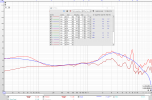- Joined
- May 8, 2020
- Messages
- 642
- Likes
- 658
Harman curve, a target developed based on preference of various test listeners and their input of an in-room flat speaker and how it would be reflected in an over-ear headphone. I do understand why some may not like, not everyone falls in the expected confidence interval of a study, and that’s to be expected in any study.
For a headphone to be successfully equalized to something close to this curve it needs to have a few characteristics:
1. A low distortion profile across the listening frequency range.
2. Good unit-to-unit frequency response compliance.
3. As few high Q (low? bandwidth) imperfections as possible.
4. Good channel tracking.
5. Enough power to drive a possible bass boost.
Developing a curve for this kind of headphone will yield the best results. I discovered all of this while researching the best headphone to equalize to this curve, and these issues ruined the final curve. But when I found my current headphone (Sennheiser HD 560S) and applied the curve, it was a complete eye-opener personally.
Another thing is that I do not use presets, both Oratory’s and AutoEQ’s presents are not straight Harman OE. They both sound different to each other, and most of the time, bad to my ears. Oratory uses ear tuning when developing his results and AutoEQ uses some variation of Harman, but with a different bass boost profile. I do use the actual AutoEQ program, but input the straight Harman curve (2018 OE) as the target, and that curve just sounds great and “right” when comparing it to the best speakers in treated rooms I’ve heard in my life. It literally transformed my 560S into a combination of the best aspects of all headphones I’ve owned (almost same soundstage as HD 800 and the same detail retrieval, almost same bass as LCD series, same “dynamic range” as Focals, and still as flat in thr midrange as the HD 600 without the lack of bass [aubjecitve]).
For a headphone to be successfully equalized to something close to this curve it needs to have a few characteristics:
1. A low distortion profile across the listening frequency range.
2. Good unit-to-unit frequency response compliance.
3. As few high Q (low? bandwidth) imperfections as possible.
4. Good channel tracking.
5. Enough power to drive a possible bass boost.
Developing a curve for this kind of headphone will yield the best results. I discovered all of this while researching the best headphone to equalize to this curve, and these issues ruined the final curve. But when I found my current headphone (Sennheiser HD 560S) and applied the curve, it was a complete eye-opener personally.
Another thing is that I do not use presets, both Oratory’s and AutoEQ’s presents are not straight Harman OE. They both sound different to each other, and most of the time, bad to my ears. Oratory uses ear tuning when developing his results and AutoEQ uses some variation of Harman, but with a different bass boost profile. I do use the actual AutoEQ program, but input the straight Harman curve (2018 OE) as the target, and that curve just sounds great and “right” when comparing it to the best speakers in treated rooms I’ve heard in my life. It literally transformed my 560S into a combination of the best aspects of all headphones I’ve owned (almost same soundstage as HD 800 and the same detail retrieval, almost same bass as LCD series, same “dynamic range” as Focals, and still as flat in thr midrange as the HD 600 without the lack of bass [aubjecitve]).


